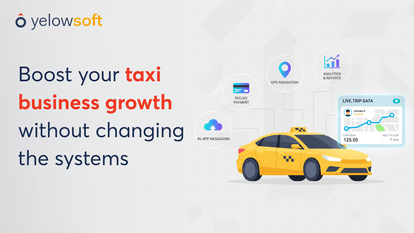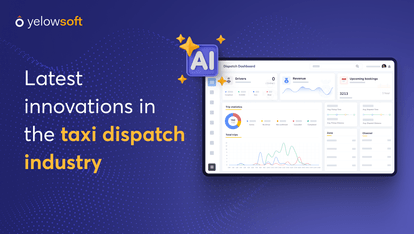The taxi industry has witnessed a remarkable technological transformation over the past three decades. What began as radio-based communication systems in the 1980s has evolved into sophisticated, AI-powered digital platforms that define modern urban mobility.
The journey from radio dispatch to digital platforms represents more than just technological progress—it marks a fundamental shift in how taxi businesses operate, compete, and serve customers. Traditional radio taxi companies that once dominated urban transport now face an existential choice: embrace digital transformation or risk obsolescence in an increasingly tech-driven marketplace.
The global taxi market, valued at USD 292.60 billion in 2025, is projected to reach USD 587.31 billion by 2033, exhibiting a compound annual growth rate of 9.1%. This explosive growth is driven almost entirely by digitally-enabled services, leaving radio-based operators struggling to maintain relevance.
Through this blog, understand this transformation—why radio systems became obsolete, how dispatch technology evolved, and what advantages digital platforms offer—is essential for any taxi business owner planning to remain competitive in 2025 and beyond.
Why Radio Dispatch Systems Became Obsolete
For decades, radio dispatch systems were the technological backbone of taxi operations. Drivers equipped with two-way radios received job assignments from central dispatchers who manually coordinated all bookings. While revolutionary in its time, this analog system carried inherent limitations that eventually made it unsustainable in the digital age.
Communication Bottlenecks and Human Error
Radio dispatch relied entirely on voice communication between dispatchers and drivers. During peak hours, this created severe bottlenecks as dispatchers struggled to manage multiple simultaneous calls. The system was particularly vulnerable to miscommunication—garbled addresses, confused pickup locations, and misheard instructions led to missed rides and frustrated customers.
Limited Scalability and Coverage
Radio systems operated on finite frequency channels, restricting the number of simultaneous communications. As fleets grew, the radio infrastructure couldn't scale proportionally. Larger operations required multiple dispatch channels and coordinators, exponentially increasing complexity and cost.
Geographic coverage posed another challenge. Radio signals weakened over distance and struggled in urban areas with tall buildings. Drivers operating on the periphery of service areas often lost contact with dispatch entirely, creating dead zones where coordination became impossible.
No Real-Time Visibility
Perhaps the most crippling limitation was the complete absence of real-time fleet visibility. Dispatchers had no way to know where drivers actually were beyond what drivers self-reported over the radio.
Absence of Customer Convenience
Radio dispatch systems offered customers zero visibility into their ride. After calling to book, passengers had no way to track their taxi's arrival, estimate wait times, or communicate changes. This lack of transparency created anxiety and frustration, particularly during urgent trips or bad weather.
Payment remained entirely cash-based, creating security concerns for both drivers and passengers. There was no digital record of trips, no automated invoicing for corporate accounts, and no way to build customer loyalty through data-driven insights.
High Operational Costs
Despite seeming simple, radio systems were expensive to maintain. Hardware required constant replacement, radio licenses needed renewal, and dedicated dispatch staff represented significant ongoing payroll expenses.
Industry data confirms that manual coordination consumed 40% of dispatch team time on redundant tasks that could be automated, driving up operational overhead substantially.
These accumulated disadvantages made radio dispatch increasingly untenable as customer expectations rose and digital competitors emerged. The system that once represented cutting-edge technology had become the primary barrier to growth and profitability.
The Digital Dawn: How Taxi Dispatch Systems Emerged and Evolved
The evolutionary journey—from radio to CAD to GPS to mobile to AI—represents a complete reimagining of how taxi businesses operate. Each technological leap addressed specific limitations of previous systems while unlocking new capabilities that were previously unimaginable.

The Competitive Advantage: How Digital Dispatch Systems Drive Business Success
Modern taxi dispatch systems deliver far more than operational efficiency—they create fundamental competitive advantages that separate thriving businesses from those struggling to survive.
1. Operational Excellence Through Automation
Digital dispatch platforms automate processes that once consumed hours of manual labor:
Intelligent Job Allocation: Algorithms instantly match ride requests with optimal drivers based on proximity, availability, vehicle type, and performance history. What took dispatchers 2-3 minutes per booking now happens in milliseconds.
Reduced Idle Time: Real-time visibility into fleet status and demand patterns keeps drivers continuously productive. Studies show automated dispatch reduces driver idle time by 30-40%, directly increasing revenue per vehicle.
Error Elimination: Automated address validation, GPS-guided navigation, and digital trip records eliminate the miscommunications and mistakes inherent to manual systems.
The IJRASET study found that digital transformation improved operational efficiency significantly, with automated dispatch being among the most transformative technologies adopted by traditional taxi services.
2. Superior Customer Experience
Digital platforms meet modern customer expectations that radio dispatch could never address:
Instant Booking: Customers book rides in seconds through mobile apps, websites, or phone integration—no busy signals or hold times.
Complete Transparency: Real-time GPS tracking shows exactly where vehicles are and when they'll arrive. Customers see driver details, vehicle information, and estimated fares before booking.
Flexible Payment: Integrated digital wallets, card processing, and corporate billing options replace cash-only transactions, improving convenience and security.
Service Quality: Two-way rating systems incentivize excellent service from drivers while protecting operators from problem customers.
Research indicates that 59.6% of taxi operators identified improved customer service as the primary benefit of digital transformation, directly impacting customer retention and satisfaction scores.
3. Data-Driven Decision Making
Digital dispatch systems generate comprehensive data that radio operations never could:
Performance Analytics: Detailed metrics on driver productivity, customer preferences, peak demand periods, and operational bottlenecks inform strategic decisions.
Demand Forecasting: Historical data combined with AI algorithms predict busy periods, allowing operators to position fleets proactively and maximize revenue.
Financial Insights: Automated reporting shows precisely which services, routes, and time periods are most profitable, enabling data-driven pricing and resource allocation.
According to industry research, 60.8% of digitally transformed taxi operators adopted data analytics tools, using insights to optimize everything from pricing strategies to fleet expansion decisions.
4. Cost Reduction and Profitability
While digital systems require initial investment, they deliver substantial ongoing savings:
Lower Labor Costs: Automated dispatch reduces the number of coordinators needed. One dispatcher with digital tools can manage workloads that previously required three radio dispatchers.
Fuel Efficiency: GPS-optimized routing and reduced idle time cut fuel consumption by 15-25%, representing thousands in annual savings per vehicle.
Reduced Disputes: Clear digital records of trips, routes, and payments minimize costly conflicts with customers and drivers.
Better Asset Utilization: Comprehensive fleet visibility ensures vehicles are used optimally, improving return on investment for every car in your fleet.
Research from Quick-Works found that operators implementing taxi dispatch software typically achieve ROI within 6-12 months, with ongoing profitability gains compounding annually.
5. Scalability and Growth Enablement
Perhaps most importantly, digital dispatch platforms scale effortlessly:
Geographic Expansion: Cloud-based systems operate anywhere with internet connectivity, allowing seamless expansion into new service areas without infrastructure investments.
Fleet Growth: Adding vehicles requires no additional dispatch staff or equipment—the system scales automatically.
Service Diversification: Modern platforms support multiple service types (standard taxis, premium vehicles, airport transfers, corporate accounts) within the same system.
Integration Capabilities: APIs and third-party integrations allow operators to connect with hotels, restaurants, corporate clients, and affiliate networks, creating new revenue streams.
The global taxi dispatch software market is projected to grow from USD 465.2 million in 2024 to substantially higher valuations by 2033, driven entirely by operators recognizing these competitive advantages and investing in digital transformation.
6. Compliance and Regulatory Benefits
Digital systems simplify regulatory compliance through automated record-keeping:
Trip Logs: Complete electronic records of all rides for tax reporting and audits Driver Management: Automated tracking of licenses, certifications, and compliance documentation Financial Reporting: Built-in tools for tax calculation, invoicing, and financial compliance Safety Features: Emergency buttons, trip sharing, and incident reporting enhance passenger safety while protecting operators legally
For UK operators, features like TfL compliance monitoring and HMRC-ready invoicing transform regulatory obligations from burdens into seamless automated processes.
Conclusion: The Digital Imperative for Radio Taxi Businesses
The AI-powered dispatch software doesn't just improve taxi operations—they fundamentally transform struggling radio-based businesses into competitive, profitable, modern enterprises.
The comprehensive IJRASET study confirms what industry leaders have known for years: digital transformation delivers significant improvements in cost efficiency, operational performance, customer satisfaction, and competitive positioning. With over 81% of industry stakeholders reporting transformative impact from digital adoption, the question is no longer whether to digitize, but how quickly you can make the transition.
Radio dispatch systems served the industry well for decades, but their limitations—communication bottlenecks, lack of visibility, poor scalability, limited customer convenience—now represent fatal competitive disadvantages. Modern customers expect instant booking, real-time tracking, transparent pricing, and cashless payments. These aren't luxury features—they're baseline requirements for remaining relevant.
For radio taxi businesses facing declining market share, rising costs, and customer attrition, digital dispatch systems offer more than survival—they provide a pathway to renewed growth and sustained profitability.
Transform your radio operated taxi business into AI-powered taxi dispatch company




